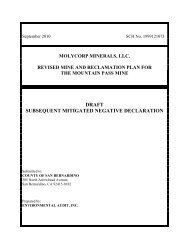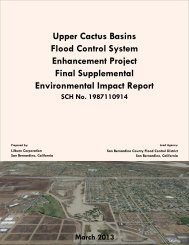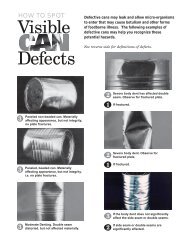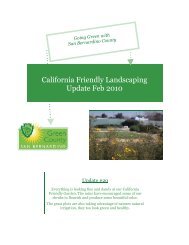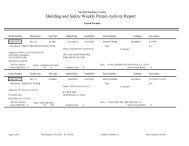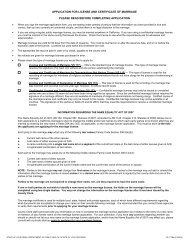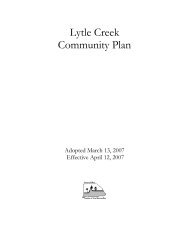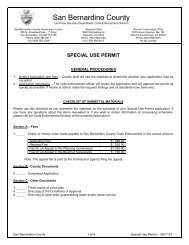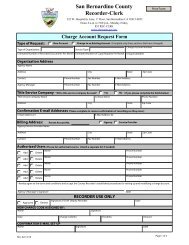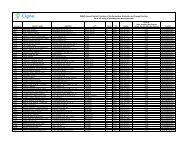San Bernardino County Business Recycling Guide
San Bernardino County Business Recycling Guide
San Bernardino County Business Recycling Guide
You also want an ePaper? Increase the reach of your titles
YUMPU automatically turns print PDFs into web optimized ePapers that Google loves.
Greetings!The <strong>County</strong> of <strong>San</strong> <strong>Bernardino</strong> produced this guide to assist businesses in establishing orexpanding their business recycling. This guide provides business owners and managementthe tools to facilitate source reduction, reuse, recycling, business waste characterizationsand other templates to sustain a recycling program along with other references andcontacts.The increased interest in recycling, especially business recycling, stems from therequirement for every city and county in the State of California to divert 50% of their solidwaste generated in their jurisdictions from landfills, as required by the CaliforniaIntegrated Waste Management Act of 1989. Every business owner in the <strong>County</strong> cancontribute to meeting this goal. The guide allows a business to take ownership of theirrecycling program through methods and worksheets for planning, preparation,implementation and program maintenance.The Solid Waste Management Division wants to thank you for taking the time to integratea recycling component into your business plan. The benefits do come in time, eithermonetarily; through cost savings or reducing the impact that businesses have onconstrained resources. Choosing to recycle more is the first step to waste reduction. If youhave any questions, comments or suggestions about the <strong>San</strong> <strong>Bernardino</strong> <strong>County</strong> <strong>Business</strong><strong>Recycling</strong> <strong>Guide</strong>, please contact the Solid Waste Management Division at 1-800-722-8004.What are businesses, residents andinstitutions throwing away?According to the Envi ronmental ProtectionAgency, in 2003, Americans generated 236million tons of municipal solid waste. Thatis approximately 4.5 pounds of wa ste perperson per day!
TABLE OF CONTENTS<strong>Business</strong> <strong>Recycling</strong> 101 ………………………………………………2Getting Started- The Nuts and Bolts…………………………………..3Drafting the Plan………………………………………………………4-6Waste Sample Assessment Form……………..…………………….....7Additional Waste Reduction Strategies……………………………….8-9Creating A Successful <strong>Business</strong> <strong>Recycling</strong> Program…………………10To Market We Shall Go………………………………………………11Offices………………………………………………………………...12-15Retail Establishments…………………………………………………16-17Hotels…………………………………………………………………18-19Restaurants and Bars………………………………………………….20-21Health Care…………………………………………………………...22-23Construction and Demolition………………………………………....24-25Additional Tracking Mechanisms and Resources…………………….26-32Glossary……………………………………………………………….33-35Contacts to Assist <strong>Business</strong>es in <strong>Recycling</strong> Efforts………………….36-37ABOUT THIS GUIDEThe first part of this guide provides essentialbackground information and guidelinescommon to all business waste reductionprograms. The second part addressesbusinesses in particular industries that youas a business owner or manager mayreference to target or customize for yourbusiness and needs. Finally, the Appendixsection contains supplemental materialsincluding assessment forms, glossary ofterms and contacts.1
<strong>Business</strong> <strong>Recycling</strong> 101The California Legislature passed the Califor nia Integrated W aste Management Act of1989, (AB 939) and every city and county in the state m ust meet the m andated 50%diversion of waste from landfills by the year 2000 and beyond. Jurisdictions that fail tomeet these targets are subject to fines of up to $10,000 per day.Since inception, not all jurisdictions have m et the 50% rate due in part to low recyclingparticipation rates and many recoverable items are still ending up in landf ills. <strong>Business</strong>and industry alone generates 60 % of California’s waste stream. Reducing the amount ofwaste a businesses produces saves valuable landfill space and decreases the disposal costsa business incurs.As a business leader, your part icipation is critical in achieving the waste diversion goalsset forth by the State. B usiness owners and managers can save money by incorporating arecycling and source reduction program into their business plan.<strong>Business</strong> recycling not only allows the <strong>County</strong> to attain state m andated goals, but thereare tangible benefits in adopting waste reduction and recycling programs.• Producing less trash through waste reduction and recycling lower disposal costs byreducing the number of trash pick-ups or the size of the bins.• Waste reduction usually results in lower procu rement costs. For exam ple, usingdouble–sided copies reduce the dem and for paper, and refilling ink jet ca rtridgesinstead of buying new ones is less expensive.• <strong>Recycling</strong> programs can become powerful marketing tools. The public is receptive tothe idea of recy cling, as demonstrated by the hig h (more than 80%) rec ycling rateattained in the State ’s beverage container recy cling programs. <strong>Business</strong>e s whichpublicize their recycling measures (see suggeste d news rele ase in the Appendixsection), find they are able to effectively project their social responsibility and that inturn can enhance their bottom line by attracting like-minded consumers.2
DRAFTING THE PLAN – STRATEGIES FOR SUCCESSThe following steps are common to many recycling programs.Step 1: Conducting the AuditThe first step in developing a recycling program requires an understanding of the business’ wastestream. A waste assessm ent determines which materials can and cannot be recycled. (seesample Waste Audit Form, page 7.)A <strong>Recycling</strong> Coordinator performs a waste audit with assis tance from the waste hauler, recycleror an outside consultant. La rge organizations should contact their local waste haulers anddevelop a plan, which will be effective in a complex environment. Depending upon the size andnature of a business, audits either range from a walk-through of the business or are systematic byfilling out a detailed information form.For some situations, it will be enough to ex amine business waste containers an d make anestimate of the types and quant ities of waste these contain. In other cases, thorough wastecharacterization evaluations may be necessary.Waste assessment should be part o f a com pany’s ongoing recycling program because wastevolumes generated usually change periodically. The <strong>Recycling</strong> Coordinator should plan to checkthe waste containers periodically.The sample audit form on page seven follows guidelines established by California IntegratedWaste Management Board (CIWMB). It provides a good basis for developing a business wastediversion plan. Samples of more elaborate waste gathering and assessment forms are included inthe Appendix.Step 2: Questions to Ask and AnswerA comprehensive recycling plan derives from data gathered from the waste audit and assessment.Implementing a recycling program works best if phased in. Divert high volum e and easilyaccessible items first, and then add other recyclable materials later.In the development of any recycling plan, it is c ritically important that the entity ch arged withthe final handling and m arketing of recyclable materials from the onset of the plan ’s design isconsidered. From this position, the rest of the pl an can be “backed into.” In doing so, ask andanswer these questions:• Which materials do we separate for recycling?• When, where and how will materials be collected?• Who will remove, process, and market recyclables?Step 3: Source Separation (Setting Up Containers)Source separation at the point-of-or igin is th e critical step in any was te diversion plan. Forexample, if an office generates high-grade white paper that can be recy cled and less valuab lemixed paper, it is a good idea to keep the two separate so as not to lower the white paper’s value.4
Containers for collecting different types of recy clable materials must be stra tegically locatedthroughout the business. Every situation will di ffer, but some successful programs include thefollowing:• Desktop (or under-the-desk) containers for recyclable paper.• Containers in copy room and computer locations.• Cans, plastics and glass containers in employee lunch/coffee break areas.• Space set aside for large recyclables or reusable items.• Containers for regular trash strategically placed throughout the office to avoidcontamination (i.e. non-recyclables thrown into recycling containers with the recyclableitems).Step 4: Collection – Transferring Recyclable Materials Out Of the WorkplaceAn efficient collection system is essential to the success of your recycling program. A janitorialor maintenance staff will serve as a vital link between those who separate recyclables and thecontractor who will remove the materials so they can be processed and marketed. The collectionphase of your recycling plan requires these steps:• Coordinate collection of recycling containers with trash collection.• Provide appropriate space for intermediate containers.• Establish a regular collection time schedule.• Provide easy access for collecto r to pick up m aterials. (Larger bus inesses may havesufficient volumes of materials to warrant an on-site baler or other compactionequipment. This will make the collection of recyclable materials easier and increase theirvolume).Step 5: Disposing Of RecyclablesAs your recycling plan develops , critical m arketing issues n eed consideration between yourbusiness and the selected waste hauler, recycler or broker, particularly in the case of businesses,which generate a high volume or recyclable materials. Do not be dissuaded if a m arket for somebusiness waste does not yet exis t. In most cases, it costs considerably more to lan dfill, a ton o fwaste than it does to recycle a ton of recyclable materials.Step 6: Monitoring and EvaluationAt the onset of your program , include a monitoring and evaluation plan, it will prov ide specifictechnical data and provide the basis for ongoi ng employee incentives. The benefits of arecycling program are far ranging and long–ter m, the monitoring and evaluation plan isimportant and will determine what short–term impact your program is having on the bottom line.Regularly evaluate baseline inform ation compiled through the waste audi t and the developm entof numerical targets establishe d in your recycling plan to determine the progress of yourprogram. Some of the key points to track:5
• Which goals were met, why or why not?• Which strategies are working best, and why?• Which strategies are not working, and why?• What are the real costs/revenues resulting from the recycling plan?• Is a meaningful level of waste diversion occurring?• Are disposal cost savings being realized?• Is the employee communication plan effective?Implementation Tactics to Consider• Work with the waste hauler or <strong>County</strong> recycling coordinator to arrange for collection ofrecyclables.• If you lease or rent space in commercial building ask the property management companyif they will provide for the collection of recyclable materials in conjunction with thecollection of waste. In some cases, a joint approach by several businesses with the sameproperty management company can be effective.• If in an office building, speak to the building manager or concierge. Buildings often haverecycling programs in which tenants can easily participate.Notes6
WASTE SAMPLE ASSESSMENT FORM1. How much waste do you produce per month? (in tons or cubic yards)2. Which of the following recy clable materials are in y our waste and what percen tage (byvolume/weight) of your total waste per month do they represent?Materials(examples)% ofMonthly WastePaper______ Corrugated boxes ____________ High quality office paper (white ledge paper) ____________ Computer paper (green bar, blue bar, dot matrix) ____________ Mixed paper (junk mail, phone books, post-its) ____________ Newspaper (daily paper, newsprint, drawing paper) ____________ Mixed grade office paper (tablets, envelopes) ______Plastics____________California Refund Value (CRV) Polyethylene Terephthalate-PETE #1 (soda,water and juice bottles) (so marked)*California Refund Value (CRV) High-Density Polyethylene-HDPE #2 (water jugsCRV only) (milk jugs, detergent bottles)____________ Vinyl/Polyvinyl Chloride (PVC) #3 (household cleaner bottles, cooking oil) ____________ Low Density Polyethylene (LDPE) #4 (plastic bags, films, trash bags, bread bags ) ____________ Other (any other type of plastic) ______Glass______ California Refund Value (CRV) (wine coolers) (so marked)* ____________ Refillable beverage bottles (marked on bottles) ____________ Other recyclable glass (jars, non-redemption) ____________ Other non-recyclable glass (window panes, bulbs) ______Metals______ California Refund Value (CRV) ((soda, beer) (so marked)* ____________ Bi-metal cans (soup, juice or vegetable cans) ____________ Non – ferrous metal (brass, copper, bronze, etc. ______Other______ Yard Waste (leaves, grass, prunings) ____________ Other organics (food wastes, wood) ____________ Inert solids (rock, concrete, asphalt, brick) ____________ White goods (appliances) ____________ Special Waste (tires, ash, sludge, rendering grease) ____________ Universal Waste – E-Waste (computer monitors, TV’s and cell phones ___________ Medical/Biohazard Waste (see Health Care Section) _____*For a complete list of Beverages subject to California Refund Value (CRV). Please refer towww.bottlesandcans.com7
ADDITIONAL WASTE REDUCTION STRATEGIESSource ReductionWaste reduction – reducing waste at the source – is a process, not one single action, thus captured by thephrase, “Reduce, Reuse, Recycle.” In other words, waste reduction not only means recycling materialsthat can be used again; it also means reusing products you’ve used before if they can still be used insteadof replaced, and using less to start with.Here are some valuable waste reduction tips, which are environmentally sound and can save money:• Return trimmings and overruns to the production process whenever possible.• Reuse paper (the clean side of paper used once can be used in laser printers when preparingdocuments intended for internal use; also paper can be used again for note–taking).• Proofread documents before printing multiple copies.• Make only as many photocopies as are strictly needed.• Make your documents double sided if more than one page.• Use Electronic Mail.• Replace your fax machine with a plain paper mode (traditional fax paper is not recyclable).• Reuse packaging containers, packaging polystyrene “peanuts” and bags.• Refill or recycle printer and copier toner cartridges.• Circulate magazines and cut down on subscriptions.• Purchase equipment that is repairable or leasing equipment is also an option.• Have departments share equipment when feasible and without disruption.• Donate obsolete materials to charitable organizations.• Substitute single use products with reusable products.• Use reusable mugs, utensils and dishes in lunchroom as much as possible.• Use cloth rags for cleaning instead of paper towels.• Use rechargeable batteries.• Centralize filing –instead of having many duplicate files –whenever feasible without disruptions.• Reuse manila envelopes internally.• Use a computer for file storage and circulate altered documents only.These are just some source reduction ideas to consi der. Evaluate y our business and identify areas forsource reduction and reuse.8
ProcurementAnother dimension to waste reduction measures, pertaining specifically to recy cling, is purchasingproducts made in part fro m recycled materials. Th is helps create a dem and – and a m arket – for therecyclable materials. That is what is meant by the phrase, “Closing the Loop” – the loop comprising thesteps of collection, processing and giving recyclable materials another life. Beyond serving a vital wast ereduction and conservation function, procurement policies create a market for recy clable materials, havelong–term economic implications, and contribute to the rise of new industries. In purchasing recy cledproducts, you obtain materials that would have otherwise gone to the landfill and strengthen markets forrecovered secondary materials. Here are some of the procurement policies that may be considered:• Notify manufacturers of your desire to buy recycled and recyclable products.• Tell your suppliers to keep packing materials down to a minimum.• Ask suppliers to shi p orders in returnable and reusable packaging and pick-up the packaging forits reuse.• Commit to purchase a set percentage of products with recycled content.• Establish minimum content standards for post–consumer materials (to thoroughly contribute towaste reduction, it is essential that some of the recycled materials used in new products to be post–consumer waste).• Buy recycled paper, and make sure that paper contains at least 25% consumer content.Composting/Grasscycling<strong>Business</strong>es, which maintain lawns, can make an enormous contribution toward keeping green waste out ofthe landfills through grasscycling (recycling grass) and composting. Some simple strategies include:• “Cut it high let it lie.” That means take off a little grass at a time and let it lie on the lawn. Shortclippings will disappear between blades in a few days and actually help fertilize a lawn.• Arrange to have grass mowed by a “mulching” t ype lawn mower, which chops grass into finepieces and puts it back into the lawn.• If practical, start a compost pile for your yard waste. Composting is the biological decompositionof organic materials into an enriched soil used as a fertilizer and soil condi tioner. However,composting is something of a science, so you m ay need to read up o n it b efore starting acomposting pile. For more information, please contact Solid Waste Management Division at thetoll free line at 1-800-722-8004.• Some cities also have a commercial green w aste program. Contact y our local re cyclingcoordinator of hauler for information.• Add a provi sion to your maintenance contract asking your groundskeeper to im plement agrasscycling and composting program.• Buy mulch and compost from your local greencycler for fertilizer.• Implement / contact a commercial food waste program.• Work with your company landscaper, if available.You can also call a local recy cling center to find out if it accepts y ard waste; see Appendix for a list ofprocessors.9
CREATING A SUCCESSFUL BUSINESS RECYCLING PROGRAMWhat drives a business – any business – is the bottom line. Th e formula for a successful business i smaximizing income, while m inimizing cost. Yet, many potentially successful businesses are literallydumping their profits.Remember, recycling saves in several ways:• It saves your business money by reducing waste disposal fees.• It diminishes the need for landfill space (every ton of paper, recycled, saves 3.3 cubic yards oflandfill space).• It saves our natural resources (for every ton of paper recycled, 17 trees are saved).• It saves energy costs (manufacturing paper products from recycled paper uses 64% less energythan paper made from virgin pulp).• It saves water (it requires 50% less water to manufacture paper products from recycled paper thanusing trees).• Finally it he lps safeguard air quality (recycled paper produces approxim ately 60% less airpollution and more than 30% less water pollution).Cost saving and socially responsible characteristics of policies include some of the following:• A commitment from the top (environmental practices/policies)• Financial support (and time) provided by management• A clear and simple plan for employees to follow• Ongoing education efforts• An incentives and rewards program• A workable collection and delivery planConversely, businesses that resist or flatly refuse to explore waste reducing habits, generally exhibit thefollowing:• Complete lack of commitment by management• A fear of change• A lack of knowledge on how to proceed• The misperception that a recycling program cost will never be recovered• A lack of understanding of the importance of recycling• Do not know how to begin, seems cumbersome10
TO MARKET WE SHALL GOIf your city/county hauler does not have a commercial program yet and you must market your recyclablesyourself, or if you opt to use a private firm to take your rec yclables (they pay you) then here are somehelpful tips.A key component of your recycling program is wh ere to send the recy clable materials once separ ated.Which recyclables will t he end-user (market) accept? In what form will the market accept myrecyclables? How do I get the recyclables to the market?Determine if the various markets accept your recyclables. Here are a few simple criteria to follow whenevaluating your material’s marketability.• Proximity of markets should be close enough to keep shipping transportation costs reasonable.• The recyclable materials should be uncontaminated (clean).• Recyclable material costs less to recycle than to send to the landfill.Should I sell directly to the market, or use a local recycler or broker?Generally, to sell directly to the market requires the recyclables be upgraded or processed. Assume yourbusiness generates three t ons of corrugated cardboard a month. The processor pays you $40 a ton forunbaled OCC, and $80 if baled. If the monthly rental of a baler is $20, it m ay prove cost effective to gothat route. However, do not forget to factor in t he cost of staff tim e to operate the baler and m eet thequality specifications.Your local recy cler will g enerally accept lower qual ity materials, and will then upgrade to send to themarket. Many recyclers accept mixed materials, saving you the time of separating all of it.A broker buys recy clables from several sources, bargains to get the best market value and then handlesthe pickup and delivery to the market.If your business is too small to generat e enough of certain recyclables to make recycling cost-effective,consider cooperative marketing with other co mpanies. Memb ers of the c ooperative can even shareprocessing equipment such as balers, chippers, etc.11
OFFICESBackgroundThere are a number of materials targeted in an office recycling campaign. Paper is a chief targetPaper is the single largest component of the municipal solid waste stream , accounting for about 3 6% ofthe nation’s waste. Offi ce paper is the third larg est category of paper waste after newspapers andcorrugated cardboard. The average American office worker throws away about half a pound of paper perday. In a financial institution, that daily average rises to about two pounds per day ; with 50 employees,that is about 24,000 pounds of paper per year going to the landfill.Beyond the strain on landf ills is the impact virgin product paper and the failure to rec ycle paper has onforests. As a rule of thu mb, recycling one ton of paper saves 3. 3 cubic yards of landfill space and 17trees.Consider, too, recycling paper saves energy and water; paper products made from recycled paper use 64%less energy and 50% less water than those produced from virgin pulp. Manuf acturing recycled paperproducts also generates 60% less air pollution an d 30% less water polluti on than manufacturing paperproducts from virgin materials.Here are some basic guidelines to follow in setting up an office-recycling program.Materials to Target• White office ledgerVirtually all types of stati onery, including white copy machine paper, t yping paper, blan k orimprinted computer paper, st eno pad paper and white envel opes without plastic windows oradhesive address labels are considered white office ledger. These are also considered high–gradepaper. However, if y ou combine them with mixed paper (see below), the value of the batch willbe reduced to the value of the less valuable mixed paper.• Computer paperThis refers to the oversized computer paper with green bars printed on it. If your office generatesonly a small volum e, it can be m ixed with th e white paper categor y described above. If yougenerate a lot, your hauler or broker may request to separate it so it can obtain a higher price as itis the highest grade of paper available because of its high fiber content.• Newsprint paperThis can be made into more newsprint, paperboard, packaging cartons or toilet paper.• Corrugated cardboardThis type of cardboard gets its name from the ridges and grooves that create a wall, sandwichedbetween two paperboards, to protect a carton’s contents. Corrugated car dboard is relativelyvaluable, and about half of the corrugated used in the United States is recycled.12
• Beverage containersAluminum, glass and plas tic. There is a ready market for alum inum; as a result, it carries arelatively high price. As for plastics, some types are recyclable and some are not. Your hauler orbroker can advise which type of plastic is recyclable in your area.• Printer cartridgesA recharged toner cartridges at half the price of a new one, sparing landfills, reducing the need toget rid of a hazardous container, and save substantial sums of m oney; the m oney wasted byAmerican businesses through the discarding of cartridges has been esti mated at $1.5 billion p eryear.Printer cartridge refilling involves disassem bling the cartridge and replacing the original drumonce with a “high yield drum” that subsequently can be used five to 10 times longer. The initialreplacement will cost about two thirds the price of a new cartridge, but subse quent refills willdrop down to half the cost of a new cartridge.To facilitate cartridge recycling, you should specify that your new machines must have refillablecartridges. Also, make sure the service contracts on your existin g machines do not preclude theuse of refillable toner cartridges.Recharging companies are in the y ellow pages under Computer Parts and Su pplies. A list ofSouthern California toner cartridge refillers and remanufactures appears in the appendix section.Another option is printer cartridge recycling programs. Many are available online and can provideyour business with mail back envelopes or other options. Visit www.earths911.org forinformation.Office Materials (Paper) That Cannot be RecycledCarbon Paper Blueprint paper Wax paperThermal fax paper Self-adhesive labels Photographic paperPlastic-coated paper Tissue paper, paper towels Paper with food on itDual material packaging (e.g.FedEx Envelopes, which haveplastic fibers)Envelopes with windows (they’reOK once the windows areremoved)Paper with adhesives (e.g. postits;but lick & stick envelopes areOK)If you are in doubt as to whether a certain paper type can be recycled, call your local hauler or recyclingcoordinator.13
Program Implementation Steps• Obtain and distribute containers for the collection of paper.o You will need at least thr ee types of containers for paper: One type located at eachemployee’s desk or where small clusters of employees work; centrally located.o You may also require a wheeled bin for transporting large amounts of paper.In some cases, mail carts, dollies or handcarts, althoug h the need for t his kind ofequipment is not necessa ry if you can use an existing custodial service to transportrecyclable paper to the container from where the hauler or recycling service collects it.o It is vitally important to make sure that all your containers comply with fire safety codes.• Desktop or under – the – desk containers (paper)o These are essential in order to begin separati ng recyclable paper at the source, which iseasier and cheaper than mixing it all up and separating it later.o Various designs and materials are available, including corrugated cardboard or plastic.Some containers can fit on a desk, so me under a desk, and others can hang on the wall.(It’s not a bad idea to survey em ployees and determine which type the y find useful andaesthetically pleasing, this helps promote consistent participation in the program.o In some cases, custodial staff will em pty these containers nightly. In other instances, itwill be necessary for employ ees themselves to transfer the contents of their personalcontainers to intermediate containers, so the individual containers should be large enoughto hold a three – day output of paper.o If you buy your container, look for so me with recycled content. If budgetar y constraintsprevent buying individual containers, or if the employer does not provide these, you canuse empty drawers, envelope boxes or cardboa rd boxes placed in the kick space under adesk.• Intermediate Containers (Paper)o These are th e containers used to gather the contents of individua l containers. Theyshould be strategically located, including in heavy traffic areas, common work areas andareas where recyclables are generated, such as copy ing rooms. There also should becentrally located containers for newspapers.o Clearly label the central containers. If a c ontainer used only for white paper, it shou ldread, White Paper Only. This minimizes contamination with mixed paper.o Central containers must be clearly distinguished from trash containers. Avoidcontaminating recyclables with non – recyclables.o If purchasing intermediate containers is not f easible, you can use tall, clean trashcans o rlarge boxes and keep them clearly labeled.o If feasible, situate interme diate containers in areas where they are easily accessible toboth employees and the people tasked with transferring the contents to storage containers,e.g., near elevators or dock areas.o Have the intermediate containers emptied on a regula r basis by either the janitorial staffor the recycling contractor.14
• Storage Containers (Paper)These will take the paper that has been deposited in the centrally located intermediate containers.Ideally, these should make collection of recy clable paper easy for y ou and your haule r orrecycling service. Commonly used storage containers include plastic, metal or canvas wheeledbins, pallet boxes, and bulk cardboard containers.• Select an area for the intermediate office storage of corrugated cardboardo Make sure employees remove contents and other foreign mate rials – tape, packagingmaterials, etc. –and then flattened boxes and kept in one big box stored out of the way.o Make sure corrugated boxes are not mixed with waxed corrugated boxes as these are no trecyclable (paper fibers impregnated with wax cannot be reused).• Arrange for the transport of recycled paper to storage / pickup areaso The ideal situation is for your hauler or recy cling service to clear out your centrallylocated intermediate containers; ensure that this task does not e nd up disrupting normalwork operations.o An option that is almost as attractive is to have custodial staff shift recyclable paper fromthe intermediate containers to the st orage containers. Stock room and mailroo memployees can also do on that task. A fourth alternate is to have a part – ti me workercome in regularly to do the transporting.o In any event, intermediate containers should be emptied into storage containers regularly.Whoever ends up performing that task will have to make sure t hat different types ofrecycling papers 1) are not mixed together and 2) do not get mixed up with trash.• Obtain and set up beverage containerso These should be set up in the high traffic places, e.g., lunchroom s, near vendingmachines, but not near restrooms.o Your hauler or recy cling service will advise whether there should be separate containersfor glass, plastic and cans.• Make arrangements to service toner cartridgeso See section on printer cartridges in section above (Materials to Target).15
RETAIL ESTABLISHMENTS(Also, see section entitled OFFICES)BackgroundAlong with their need to dispose of their own recyclable materials, retail establish ments – especiallygrocery stores – shoulder an especially important responsibility with respect to waste reduction. The factis retailers contribute to t he waste stream just about every time someone walks out of a store with ashopping bag.Both paper bags and plastic bags have environmental shortcomings. Althou gh recyclable, most papershopping bags consist almost exclusively of virgin materials since recycled paper does not have enoughfibers to provide the required strength. As for plastic bags, most are made of petrochemical resins and arenot biodegradable although some plastic bags made from 30%, recycled milk jugs.This section offers number of strategies through which retailers can reduce the number of bags that comefrom stores.Targeted Materials• Shopping bags (reduction of)• Corrugated cardboard• Other packaging materials• White paper• Newspaper• Mixed paper• Beverage containers• Clothes hangers – particularly related to dry cleaningProgram Implementation Steps• Reduce shopping bag use through the following measures when feasible: Offer customers a smallincentive to bring their own shopping bags; some markets take a nickel a bag of f the grocery billof every shopper who brings back a paper or plastic bag and reuse it.o Have clerks ask, “Do you need a bag” before asking whether paper or pl astic ispreferred.ooSet up bins where customers can bring worn – out bags for recycling.Sell cloth gr ocery bags, which can be orde red bearing your logo, or which can bepurchased from several environmental organizations.• Explore other waste reduction strategies, e.g.:oAs a matter of policy, work with vendors / suppliers in requesting items without excesspackaging, eliminating packaging altogether when feasible.o When packaging is needed, ask suppliers to provide packaging that is reusable;correspondingly, establish a system whereby reusable packaging is saved and stored.16
oooUse packaging that is recyclable and that includes post – consumer recycled content.When appropriate donate old or outdated merchandise rather than dump it in the trash.When remodeling produces construction debris in large amounts, arrange to have itrecycled, donate it to institutions that may need it or advertise i ts availability throughSB<strong>County</strong> MAX at www.sbcountymax.org• General recyclingo Conduct an especially detailed waste audit; given the likelihood that y our businessgenerates recyclable materials in large quantities.o The biggest source of waste and recy clable materials generated by a retailer stems fromshipping and receiving, pay special attention to corrugated cardboard in conducting youraudit.o Since a retailers recy clable materials can be voluminous, carefully consider handlingoptions; for a retailer, it may make more sense to deal with a recycling service than with ahauler.o Determine if, in your circumstances, obtaining a baler or com pactor makes sense; inseveral instances, it will.o If the public is likely to have access to contai ners used for recy clables, have containersproperly labeled and accessible trash containers to minimize contamination.o In businesses where employees separate recyclable materials, make certain the necessarycontainers are located away from sales and service areas.o Incorporate a paper-recycling plan within your overall recycling program. (See sectionon office recycling.)o Flatten all corrugated cardboard boxes. Make sure not to mix in waxed corrugated boxes,as these are not recyclable. (Paper fibers impregnated with wax are not reusable.)17
HOTELS(Also, see sections entitles OFFICES and RESTAURANTS)BackgroundWaste reduction can save a hotel a good deal of money in the end. First, there is a market for much ofwhat you can recycle. Second, a hotel often will have the ability to deliver recyclable materials directly torecycling centers. Third, an effective recycling program will reduce disposal costs.An important aspect in w aste reduction at hotels is to enlist ide as and help f rom employees. Here aresome strategies to assist beyond just waste reduction.• Cutting down on water usage – taps, sho wers, toilets – through the use of water – saving devicessuch as modern shower heads, faucet aerators, photo electric cell start – stop flow controls forwashrooms taps and urinals, and by rapidly fixing leaky taps.• Cutting down on energy usage by using co mpact fluorescent bulbs in lieu of incandes cent;painting wall and ceilings in light colors to reflect more light, refraining from turning on washersan dryers until they’re full; etc.• Using only re-refined motor oil.• Cutting back on use of aerosol products• Disposing of toxic waste safely at all times and cutting down on toxic waste in the first place byusing non – toxic substitutes (water and baking soda in lieu of oven cleaner, water – based paintinstead of oil paint, cedar chips rather than moth balls, potpourri instead of air fresheners, etc.).• At check in, ask guests if they need anything – soap, shampoo, shaving cream, etc. – and offer todeliver it to their room. This effort will help reduce waste sinc e many travelers carry their owntoiletries.One of the greatest contributions a hotel can make to waste reduction is through it purchasing policies.Targeted MaterialsGeneral• Glass• Aluminum and steel cans• Food waste• Plastics• Newspaper• Clothes hangers• Corrugated cardboardOffice Waste• Office paper• Printer cartridgesProgram Implementation Steps• Phase out:-Individual sugar packages-Individual creamers-Individual condiment containers-Disposable cups18
• Reduce packaging; buy in bulk instead and, if some supplies have to be p ackaged, use yourinfluence to demand less packaging from suppliers and manufacturers.• Avoid supplies packaged in polystyrene foam, which virtually never decomposes.• Avoid buying and selling items packaged in blister – plastic on cardboard.• Buy shampoos and cleaning supplies in bulk.• Return wire hangers to laundries instead of discarding them.• Deliver newspaper to guest rooms folded – not wrapped.• Adopt an aggressive program to r ecycle bottles and other recy clable containers. A 475 roomhotel can generate about 10,000 of bottles of liquor and wine in a month!• Adopt an equally aggressive paper-recycling plan (see office recycling section).• Stay persistent in instituting a grasscycling and composting program to cut down on green waste.• Work out a system of recyclable material collection and storage that meets your needs, based onthe layout of your facility.Unless there are alternative arrangements with your hauler, different types of recyclable materials shouldbe separated at the point of generation.Different types of containers will be required – for e xample, stacking containers or individual containersin bar and kitchen areas, saddlebags for housekeeping cards for guest room collection and decorativecollection containers for recyclables on hotel grounds.You also will need secondary containers – wheel to ter carts, which generally are 60 or 90-g allon plasticcans with attached lids – to transport recyclable materials on hotel grounds.Storage containers located near a service area exit may consist of one large co mpartmentalized roll – offor smaller dumpsters. Sto rage containers can be l eased or purchased through wast e haulers, recyclingcompanies or purchased directly from manufacturers or distributors.• Avoid using aerosols, as aerosol containers are not recyclable; instead use pump spray dispensers,which are cheaper and can be refilled and reused for years.• Adopt a guest recy cling program, equipping rooms with recycling containers in which gue sts –after receiving their instructions from brochures and / or TV screens can deposit glass bottles,plastic containers, cans and newspapers. In addition, recycling containers can be placed on e achfloor of the hotel near th e elevator and the ice dis penser, and near the pool and the vendingmachines.• Put in place a program to recycle materials generated by your fleet of vans and cars. This caninclude:o <strong>Recycling</strong> motor oil through authorized garages or, where applicable, your municipalHousehold Hazardous Waste programs; also, if using service stations for oil changes, useonly those that recycle their motor oil.o Having tires retreaded whenever feasible.• Consider donating shampoo and soap left by guests only slightly used to shelters and othercharities thus providing useful items to people who can use them, and keeping the items out oflandfills.19
RESTAURANTS AND BARS(Also, see section entitled OFFICES)BackgroundAs is the ca se with most other businesses, restaurant and bars have good reason to see waste reductionfrom three perspectives: as a contribution to reduci ng the was te stream, as a way to project socia lresponsibility to customers, and as a way to cut costs, which can be achieved in part by reducing disposalcosts.Key materials to target include cardboard, cans and glass these materials represent about 60% of arestaurant’s waste stream, and food waste accounts for almost 30%.Dealing with the recyclable materials a restaurant or bar generates is straightforward. The st rategies fordealing with these materials include cutting on excess packaging, donating food to charities, sending foodwaste to composting facilities, and setting in place traditional recycling programs for cans and glass.However, there are spe cial considerations. An establishment serving fo od needs to m aintain highstandards of h ygiene, which means not letting waste or even recy clable materials, lie around for verylong. You also want to keep most recycling activities, including storage, out of your customer’s sight.Targeted Materials• Aluminum and steel cans• Glass• Food waste• Office paper• Plastics• Corrugated cardboardProgram Implementation Steps• Eliminate single-serve packaging, such as:o Coffee creamerso Sugar and sugar substituteo Cereal• Reduce over – packaging; buy in bul k instead. This, in itself, will dramatically reduce thevolume of waste you generate.o With supplies that need t o be package d, use your influence to dem and less p ackagingfrom suppliers and manufacturers; also, insist on being kept infor med of new productsrelying on minimum packaging.• Kitchen products available in bulk include, among others:o Syrupso Condensed soupso Yeasto Soupso Flavoringo Condiments (bought in bulk, condiments can then be dispensed fro m refillablecontainers)20
• Use carbonators and siphons instead of bottled soda water.• Buy other beverages in concentrate or bulk form whenever possible. Whe never that is notpossible, make sure your beverages come in returnable bottles or recyclable containers.• Buy bar mixes in concentrate form rather than ready-to-mix.• Offer straws from dispensers rather than individually and pre – wrapped.• Use reusable coasters or nothing at all instead of paper napkins when serving drinks from the bar.• Minimize excess use of trash bag line rs by first compacting trash; also, use liners made ofrecycled HDPE #2 instead of LLDPE or LLDPE #4. HDPE – liners contain less raw materials,usually cost less, and they work just as well.• Use reusable table linen and dinnerware instead of the disposal variety.• Use hot-air hand dryers in restrooms instead of paper towels.• Monitor inventory and cut back if you find you are always throwing away perishables.• If food served to custom ers is constantly thrown away because there was too much on a plate,reduce the portions.• Donate unserved food to a local food bank or other charity.*• Rotate perishable stock to eliminate waste due to spoilage.• Use vegetable and meat trimmings for soup stock.• Adopt aggressive recycling programs for cans, bottles and corrugated cardboar d; place recyclingbins in safe, convenient areas for wo rkers and, if appropriate, attrac tively adorned bins forcustomers.• Set up rendering service for your waste grease, fat or used cooking oil; rendering companies treatthese items and you cannot throw these materials into the trash.*California’s “Good Samaritan” law states a food serving facility may donate a food to a food bank or any nonprofit charitableorganization for distribution free of charge. T he donor will not be held li able for dam ages or injur y resulting from theconsumption of donated food unless negligence, recklessness or intentional misconduct was involved.21
HEALTH CARE(Also, see section entitled OFFICES and RESTAURANTS)A Little BackgroundNearly 75% of the waste generated b y hospitals is of the non-hazardous variety . The single bigges tcomponent of a hospital’s waste is paper, followed by food and other organic materials, followed b yplastics.All of which means that, when it comes to waste and recyclables, hospitals aren’t all that different fro mother sectors of the business community; in fact, the Office <strong>Recycling</strong> strategies set our elsewhere in thismanual are a must for hospitals. However, hospita ls do have special considerations, even withou tconsidering hazardous waste. The program implementation steps section below seeks to address some ofthese considerations.Targeted Materials• Mixed paper• Computer paper• Mixed paper• Corrugated cardboard• Beverage containers• Green waste• Food wasteProgram Implementation Steps(Please note medical/biohazard waste disposal is not addressed in this manual. For specific informationvisit .)• Consider using reusable containers for sharp medical instruments instead o f the disposablevariety. Check with your supplier for availability.• Buy cleaning substances i n large drums that are refillable by the supplier, and have staff mixcleaning solutions from concentrates.• Use washable mops instead of disposable ones.• Buy in bulk whenever possible.• Wherever it is safe, use cloth towels instead of disposable ones.• Use reusable patient ite ms instead of the dis posable variety (water pitchers, glasses, bedpans,etc.).• Make sure each patient receives only one adm ission kit rather than kits fro m differentdepartments.• Whenever it is safe, use washable linens, pillows, bed pads, under pads and quilts rather tha ndisposables.• Eliminate seldom-used items from custom surgical packs.• Consider using reusable medical instruments instead of auto matically procuring the dispo sablevariety.• Consider purchasing washable surgical and isolation gowns and sterilization trays.• <strong>San</strong>itize and reuse graduated measuring containers and plastic fracture pans.22
• Donate unused operating room supplies for use overseas.• Use reusable eating utens ils instead of the disp osable variety or com postable utensils. Visithttp://www.calrecycle.ca.gov/Organics/Food/ for information• Use a bulk milk dispenser for patients instead of individual milk cartons.• Donate unserved food to a local food bank or other charity.*• Adopt an aggressive paper, glass, and can recycling program, making sure that intermediatecontainers located in high – waste-generating areas, readily accessible to employees.• Adopt an aggressive grasscycling program.• Be water wise when planting; look for plants that require less water for landscaping. Visithttp://www.thegarden.org/siteDocs/Nifty50_2006.pdf for a list of plants.• Donate used item s that can still be useful (e.g ., containers, fol ders, binders, and other officesupplies). Or donate it to institutions that may need it or advertise its av ailability throughSB<strong>County</strong> MAX at www.sbcountymax.org*California’s “Good Samaritan” law states a food serving facility may donate a food to a food bank or any nonprofit charitableorganization for distribution free of charge. The donor will not be held liable for damages or injury resulting from theconsumption of donated food unless negligence, recklessness or intentional misconduct was involved.Notes23
CONSTRUCTION AND DEMOLITIONBackgroundFor the purpose of this manual, construction, de molition, and inert wast e (C & D) is materialgenerated in the construction and dem olition of buildings, roads, homes, facility improvements, andlandscaping. This wast e stream includes, am ong other materials, concrete, asphalt, gy psum, woodwaste, glass, ferrous and non-ferrous metals, red clay brick and corrugated cardboard.C&D waste makes up a significant amount of the general waste stream. In California C&D accountsfor nearly 22% of the solid waste stream.As is the case in most sectors, effective programs to reduce wa ste in C & D, diverts su bstantialvolumes of materials from landfills, conserves nat ural resources by decreasing the need for virginmaterials, and saves C&D contractor’s a great deal of money.For example, tipping fees for concrete and asphalt at Class III landfills can average $34.30 per ton –compared to as little as $10 per load at concre te and asph alt recycling facilities. Althoughtransportation costs represent a significant concern, contractors should know that many haulers offerreduced fees for materials separated at the source.Contractor’s also have numerous options to sell or donate recy clable products and materials thatotherwise would end up in landfills. Up to 50% of C&D materials are recyclable. These are mainlyClass I materials – external construction debris. Class II materials – internal construction debris suchas wood, plasterboard, metals etc. – can be successfully recycled through salvage programs, includingprograms that involve removal before mechanized demolition begins.C&D materials can be recy cled into a variety of useful products that reduce the need fo r virginmaterials. Concrete and asphalt waste can be crushed for use as aggregate base in road construction,red clay brick of good quality can be reused in building materials, and the potential for wood wastesis virtually boundless.Targeted Materials• Wood (lumber, pallets, green waste)• Concrete (dirt and rocks)• Asphalt• Glass• Ferrous and non-ferrous metals• Roofing materials• Red clay brick• Corrugated cardboard• Plastics• Fiberglass24
Program Implementation Steps• Conduct an audit to assess the am ounts and co mposition of your waste, the frequency ofgeneration and the space available for separation of materials and storage.• Based on your assessment, determine which materials to separate out from mixed wastes.• Practice reduction through sound management and planning. “Measure twice cut once.”• <strong>Recycling</strong> at the job site:o Use separate bins for each recycling material.o Clean-up responsibly – do not throw out what can be recycled.o Coordinate an effective recycling program with your hauler.• Close the Loop / Buy aggregateo Companies working in the construction in dustries can assist t he recycling cause bybuying recycled products.The Reuse Concept<strong>Recycling</strong> is great, but reuse is better! <strong>Business</strong>es can save mone y byreusing materials and products that ha ve multiple uses or used more thanonce. Separate and reuse materials in their existing form at the site or byother businesses and organizations. This requires so me advancedplanning but by participating in a materials exchange, a co mpany canimprove its bottom line: reducing disposal fees and saving money. Thereare several organizations that may be able to reuse your unwantedmaterials:If you no longer have need for products or materials and costly disposal isnot an option look to SB<strong>County</strong>MAX, an on-line service that pr ovideslistings of “available” and “wanted” re usable waste materials or exces smaterials generated by a variety of businesses. <strong>Business</strong>es or individualscan use the site to look f or low cost materials or post reusable or excessmaterials. For SB<strong>County</strong>MAX, please visit www.SB<strong>County</strong>MAX.org toview or place an ad, it is fr ee or call 1-800-722-8004. SB<strong>County</strong>Max is apartnership between <strong>San</strong> <strong>Bernardino</strong> <strong>County</strong> and the California IntegratedWaste Management Board.Tell them you found itin SB<strong>County</strong>MAX!Habitat for Humanity – <strong>San</strong> <strong>Bernardino</strong> AreaA non-profit organization, Habitat for Humanity uses volunteer labor and dona ted materials to buildand rehabilitate housing for low-income families, and then sells them at cost. This organization reliesheavily on donations for its building su pplies, and often is in need of a wide variety of constructionmaterials. They are always in need of ply wood and dimensional lumber. Habitat for Humanity haslimited storage space, moves from site to site, a nd must comply with strict building codes; anydonations require pre-approval and arranged with the organization in advance. If y ou have anymaterials for donation, contact Habitat for Humanity, <strong>San</strong> <strong>Bernardino</strong> Area, 1235 Indiana Court, Suite111, PO Box 1550, Redlands, California 92373 or call 909-307-2362 or email habitatsb@gmail.com.Visit their website at www.habitat4humanity.net for more information. .25
ADDITIONAL TRACKING MECHANISMS AND RESOURCES<strong>Business</strong>es interested in obtaining information about waste r eduction to supplem ent this manual havehundreds of options – government agencies and trade associations to call and manuals to consult. The listis not comprehensive and not intended as an endorsement.With respect to m onitoring / tr acking mechanisms, these can be si mple or as elaborate as a businessrequires. The main body of this manual provides a simple audit worksheet for businesses to use in gettingtheir waste reduction program started. For the bene fit of businesses with more extensive informationrequirements, the section includes additional worksheet samples.TOPICS1. Memorandum to Employees (Sample)2. Press Release (Sample)3. Monitoring and Evaluation WorksheetSection A Start-up costs for recyclingSection B Projected Annual <strong>Recycling</strong> Operation CostsSection C Projected Materials RevenuesSection D Benefits SummaryTable1 Benefits: QuantifiableTable2 Benefits: Non-QuantifiableSection EEstimated Costs and Benefits4. Glossary5. Contacts to Assist <strong>Business</strong> in <strong>Recycling</strong> Efforts26
MEMORANDUM(Sample)TO:FROM:SUBJECT:All Employees<strong>Business</strong> OwnerOur New <strong>Recycling</strong> ProgramI am proud to announce that we will launch a comprehensive recycling program beginning___________. At the urging of several of our employees, as well as responding to requirementsplaced on the City of ____________________ to meet new statewide waste diversion goals, weare committing the necessary resources to do our part.Many of you are already recycling at home. Now, it is time to extend that effort to theworkplace.I truly believe that with your support, we can make a significant impact on helping ourenvironment. With a little effort by each of us, it will not take long t achieve worthwhile results.These measures also will save our company a significant amount of money in the end._________________ has agreed to serve as our “<strong>Recycling</strong> Coordinator.” Please know thathe/she has my total support in this effort.Specific details of our programs will be forthcoming. I hope you are as excited as I am about ourcompany’s future contributions to the environment.President / Chief Executive Officer27
PRESS RELEASE(Sample)ZYX COMPANY ANNOUNCES MAJOR RECYCLING PLANPRESIDENT EXPECTS TO SAVE $40,000 IN FIRST YEAR(<strong>San</strong> <strong>Bernardino</strong>, CA) – Fearless leader, president of XYZ Company of <strong>San</strong> <strong>Bernardino</strong>,California, announced today that his company is undertaking a major recycling program beginningJanuary 1, 200X.“I truly believe that with the support of all of our employees, we can make a significant impact onhelping our environment,” said Fearless Leader. “With a little effort by each individual, includingmyself, it won’t take long to achieve worthwhile results.”According to leader, XYZ Company, which manufactures state-of-the-art widgets, expects tosave more than $40,000 in the first year of the program, just by recycling paper and corrugated cardboard.“<strong>Recycling</strong> is the best answer to our society’s growing waste disposal problem,” Leader said.“First of all, it diminishes the need for landfill space (every ton of paper recycled saves three cubic yardsof landfill space), and second, it saves our natural resources (for every ton of recycled paper, 17 trees aresaved).”Leader and the XYZ Company have issued a challenge for other businesses in <strong>San</strong> <strong>Bernardino</strong><strong>County</strong> to join them in saving the environment by initiating their own recycling programs.###28
MONITORING AND EVALUATION WORKSHEETDate____________________ Name ______________________Enter all costs you will incur in implementing a recycling program.These are one-time start-up costs. Analyze them according to your company’s schedule if youwish to compute the benefits of the program.Section AStart-up costs for RecycleStart-up costsDesign, Planners, ConsultingSite or Location PreparationBuilding AlternationsInstallation of UtilitiesOthers:Internal collectionHamper of binsPermanent signsDesktop containers<strong>Recycling</strong> containersPallet jacksOther:External collection systemsDumpstersVehicle:Vehicle:Equipment:Other:Subtotal, GeneralSubtotal, InternalSubtotal, ExternalTotal Start-up Costs29
Section BProjected Annual <strong>Recycling</strong> Operating CostsITEM DIRECT COST % ALLOCATED TORECYLINGOverheadSpace RentalMaintenanceUtilitiesAdministrationOtherNET COST FORRECYLINGSubtotal OverheadStaff<strong>Recycling</strong> ManagerMaintenanceEquipment OperatorOtherSubtotal, StaffEquipmentFuel, tires, oilMaintenanceSupplies & partsReplacementOtherSubtotal, EquipmentEducationProduction/PrintingAdvertisingDistributionConsultingOtherSubtotal, EducationTotal <strong>Recycling</strong> Operations Cost (add all Subtotals)Yearly Amortized Cost of Start-Up (from section A)Total Annual capital & operating costs of recycling30
MONITORING AND EVALUATION WORKSHEETDate _____________ Name ____________________Section CProjected Materials RevenuesA B C D E FMaterials Estimated Expected Revenues Expected Fee EstimatedQuantity per Price per ton (B X C ) Per Ton Quantity perYear in Tons (worksheet 6,(for those Year in tons(worksheet 5, Section C & D)Materials with (B X E)Section D)Marketing fees)1.2.3.4.5.6.Total Revenues Total CostMaterialsRevenues andCostsTotal MaterialsRevenueMinus TotalMaterials Cost= Net Materials Revenue CostSection DBenefits SummarySummarize benefits from recycling. Some may not be precisely calculable.Table 1Benefits: Quantifiable Value in $<strong>Recycling</strong> Revenues (from Section C of this Worksheet)Savings in Waste Management (worksheet 9, section G, table 2)Reduce Staffing (estimated value)Other Reductions:Total Quantifiable Benefit (add all lines)31
MONITORING AND EVALUATION WORKSHEETDate _______________ Na me __________________Table 2Benefits: Non-quantifiable(examples: regulatory compliance, improved public relations etc.)Section EEstimated Costs and BenefitsTotal Quantifiable Benefits (section D, Table 1)Total <strong>Recycling</strong> Costs (section B)Total Benefit Cost (subtract line 2 from line 1)32
GLOSSARYBalerA machine used to compress and bind recyclables for shipment and storage.“Closing the loop”Refers to the steps of sorting, collection, processing and giving recyclable materials another life.The purchase of recycled-content products in an attempt to expand m arket demand for thesematerials, thereby providing an economic incentive to divert materials from disposal.CompostA mixture that cons ists largely of decaying or ganic matter and is used for fertilizing an dconditioning soil. Greens + Brown + Air/Water = Compost!CompostingThe biological decomposition of organic materials such a leaves, grass clippings, brush and foodwaste into a soil amendment.Computer paperOversized paper on which green b ars are printed. To be recycled, the paper m ust be untreatedand uncoated.Corrugated cardboardThis type of cardboard gets it nam e from the ridges and grooves that create a wall sandwichedbetween two paperboards, to protect a carton’s content.E-WasteThis electronic equipment is near th e end of its useful life. Televisi on and computer monitorsare considered hazardous E-waste and must be disposed of properly.FerrousDerived from iron. An aluminum beverage can is an example of a ferrous metal. Ferrous metalsare usually separated from non-ferrous metals with a magnet. Thus, a good test to determine if ametal is ferrous or non-ferrous is to apply a m agnet to it. A ferrous m etal should not attract themagnet.GrasscyclingThe waste prevention practice of leaving grass clippings on a lawn while m owing, which allowsthe nutrients to return to the soil.HPDE #2High-density polyethylene. This type of plastic is used in milk jugs, detergent bottles and motoroil containers. HDPE is cloudy or cloudy.LDPE #4Low Density Polyethylene. This ty pe of plastic is used in plastic bags, films, trash bags, breadbags.33
GLOSSARYMixed waste paperA mixture of various grades of recycled paper. Any form of colored (non-white) paper plus anypaper with a colored backing. Includes yellow-pad paper, buff paper and recycled paper.MulchThe practice of layering organic m aterial (usually shredded yard trimmings, straw, decorativebark or compost) on top of the ground to insu late and protect it from erosion, tem peratureextremes, moisture loss and weed growth. A g ood way to m anage lawn clippings is with amulching lawnmower.Non-ferrous metalsMetals, which contain no iron. Examples include br ass, copper, tin and stee l. Ferrous m etalsare usually separated from non-ferrous metals with a magnet. Thus, a good test to determine if ametal is f errous or non -ferrous is to apply a magnet to it. Non-f errous metals will attr act amagnet.Office paperIncludes ledger, computer and bond papers.PET #1Polyethylene terephthalate. This type of plastic is used f or soda, water and juic e bottles andpeanut butter jars. PET is clear.ProcurementThe purchasing of something, especially for a company, government, or other organizationIn this case the purchase of recycled-content products in order to close the loop.Reduce, reuse, recycleCommonly referred to as the “3 Rs”. Buying products that ar e less toxic or contain lesspackaging, using reusable cont ainers and other reusable ite ms, maintaining and repairingproducts, participating in recycling program s, and buying products m ade from recycledmaterials.<strong>Recycling</strong>The process of collection, sorting, cleansing, treating and reconstituting m aterials that wouldotherwise become solid waste, and return them to the economic mainstream in the f orm of rawmaterial for new or reconstituted products which meet the quality standards necessary to be usedin the marketplace.Re-refiningThe use of petroleum refining techniques on used motor oil to produce lubrication stocks.Solid WasteUnwanted or discarded solid materials: trash, garbage and rubbish.34
GLOSSARYSorted white office ledgerPrinted or unprinted s heets of white ledge r, bond, writing and o ther papers. Preventcontamination by keeping your collection free of treated, coated, padded or heavily printed stock.Source reductionThe action that reduces the generation of waste at its source. Som etimes referred to as wasteprevention.Source separationThe act of segregating recyclable or com postable materials from other m aterials in the wastestream at the point of generation.Three (3) cubic yards binA 3 cubic yard bin is about the size of a 10-foot square room. Every ton of paper recycled saves3.3 cubic yards of landfill space.Tipping feesThe charge assessed for unloading solid waste at a disposal or transfer site.Waste diversionThe combined efforts of waste prevention reuse, recycling and composting practices.Waste minimizationRefers to eliminating, reducing and recycling of hazardous waste.Waste preventionAn action that reduces the generation of waste at its source. Som etimes referred to as sourcereduction.Waste reductionThe combined efforts of waste prevention, reuse, composting and recycling practices. (Note:Some organizations use this term synonymously with waste prevention, while others do not.)35
CONTACTS TO ASSIST BUSINESSES IN RECYCLING EFFORTSCOUNTY OF SAN BERNARDINOPublic Works Department/Solid Waste Management Division222 W. Hospitality Lane, 2 nd Floor<strong>San</strong> <strong>Bernardino</strong> CA 92415-00171/800/722-8004 or 909/386-8701www.sbcounty.gov/dpw/solidwasteFire Department/Hazardous Material DivisionCESQG Program2824 East “W” Street<strong>San</strong> <strong>Bernardino</strong> CA 92415-0799909/382-5401 or 1/800/OILYCAT (645-9228)www.sbcfire.org/hazmat/hhw.aspCALIFORNIA DEPARTMENT OF CONSERVATION DIVISION OF RECYCLING801 K Street, MS 24-01Sacramento CA 95814916/322-1080www.consrv.ca.gov\DOR\CALIFORNIA INTEGRATED WASTE MANAGEMENT BOARD (CIWMB)1001 I Street (PO Box 4025)Sacramento CA 95812-4025916/341-6000 (General Information)<strong>Recycling</strong> Hotline: 1/800/CLEAN – UP / Earth 911www.ciwmb.ca.govCalifornia Materials Exchange (CalMAX)1001 I Street (PO Box 4025)Sacramento CA 95812-40251/877/520-9703www.calmax.orgConstruction & Demolition http://www.ciwmb.ca.gov/ConDemo/Financial Assistance: http://www.ciwmb.ca.gov/Grants/Market Development Resources: http://www.ciwmb.ca.gov/Markets/Used Oil <strong>Recycling</strong> Program: http://www.ciwmb.ca.gov/UsedOil/California Waste Prevention Information Exchange www.ciwmb.ca.gov\wpie\Organic Materials Management http://www.ciwmb.ca.gov/Organics/<strong>Business</strong> Resource Efficiency & Waste Reduction http://www.ciwmb.ca.gov/BizWaste/36
U.S. ENVIRONMENTAL AGENCY SOLID WASTE SECTIONU.S.EPA Region 975 Hawthorne Street<strong>San</strong> Francisco CA 94105415/947-80001/866/EPA-WESTwww.epa.gov/region09/CITY CONTACTSCity of Adelanto 760/2 46-2300Town of Apple Valley 760/240-7521City of Barstow 760/2 56-3531City of Big Bear Lake 909/866-5831City of Chino 909/6 27-7577City of Chino Hills 909/364-2700City of Colton 909/3 70-3377City of Fontana 909/3 50-6760City of Grand Terrace 909/430-2226City of Hesperia 760/9 47-1589City of Highland 909/8 64-8732City of Loma Linda 909/799-4400City of Montclair 909/6 25-9414City of Ontario 909/3 95-2040City of Rancho Cucamonga 909/477-2740City of Redlands 909/7 98-7529City of Rialto 909/8 20-2622City of <strong>San</strong> <strong>Bernardino</strong> 909/384-5549City of Twentynine Palms 760/367-6799City of Upland 909/9 31-4270City of Victorville 760/955-5086City of Yucaipa 909/7 97-2489Town of Yucca Valley 760/369-720937
<strong>County</strong> of <strong>San</strong> <strong>Bernardino</strong>Public Works DepartmentSolid Waste Management Division222 W. Hospitality Lane, 2nd Floor<strong>San</strong> <strong>Bernardino</strong>, CA 924151-800-722-8004www.sbcounty.gov/dpw/solidwastePrinted on recycled38




